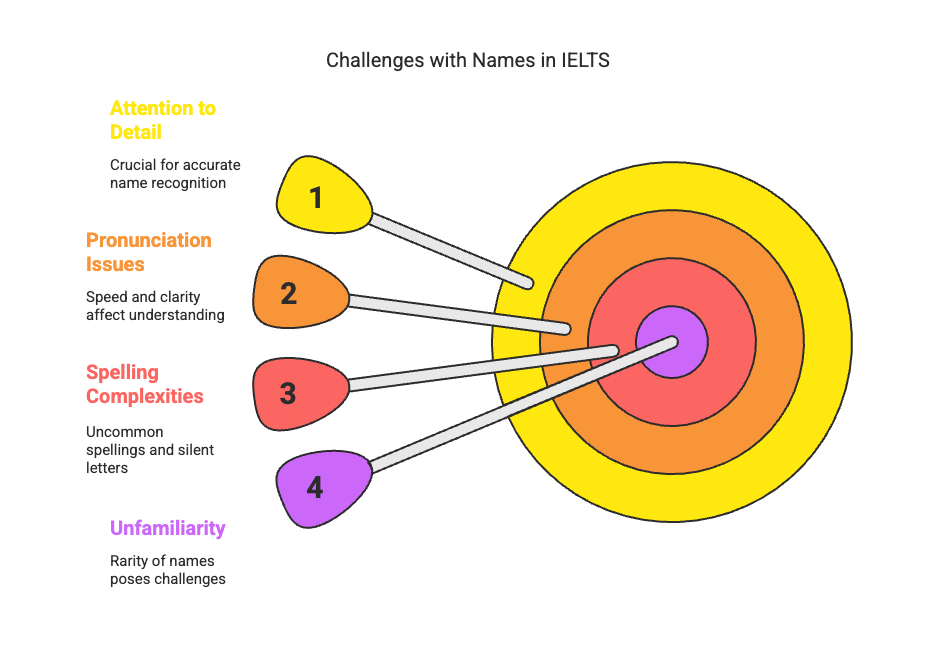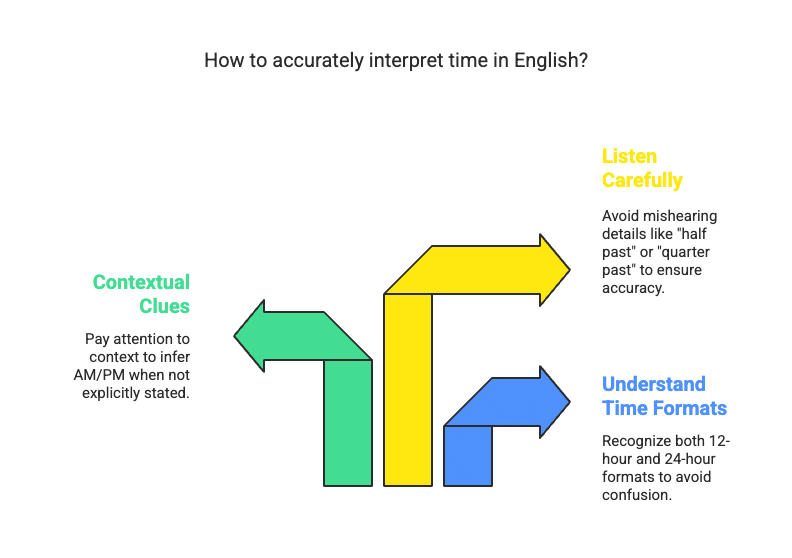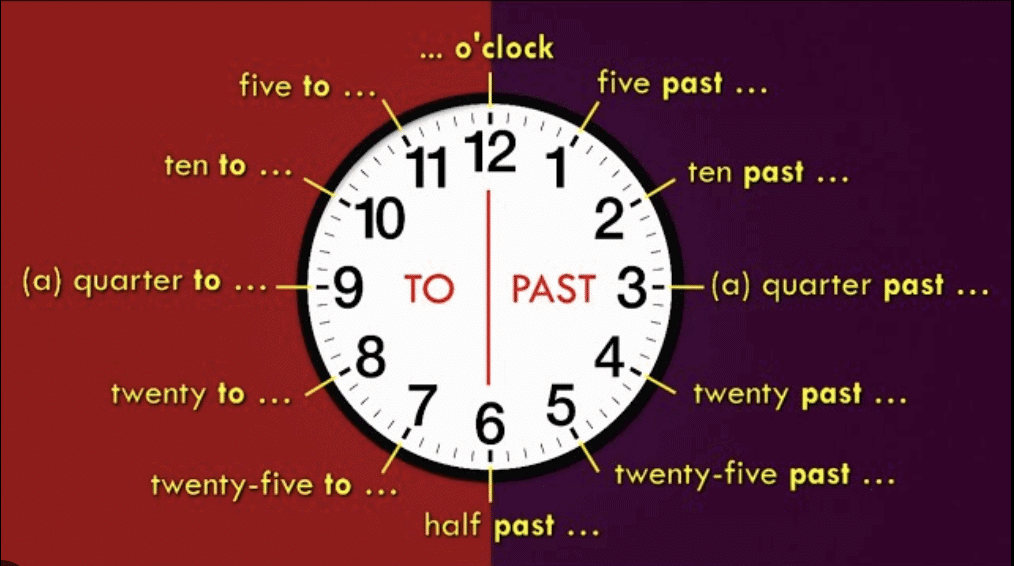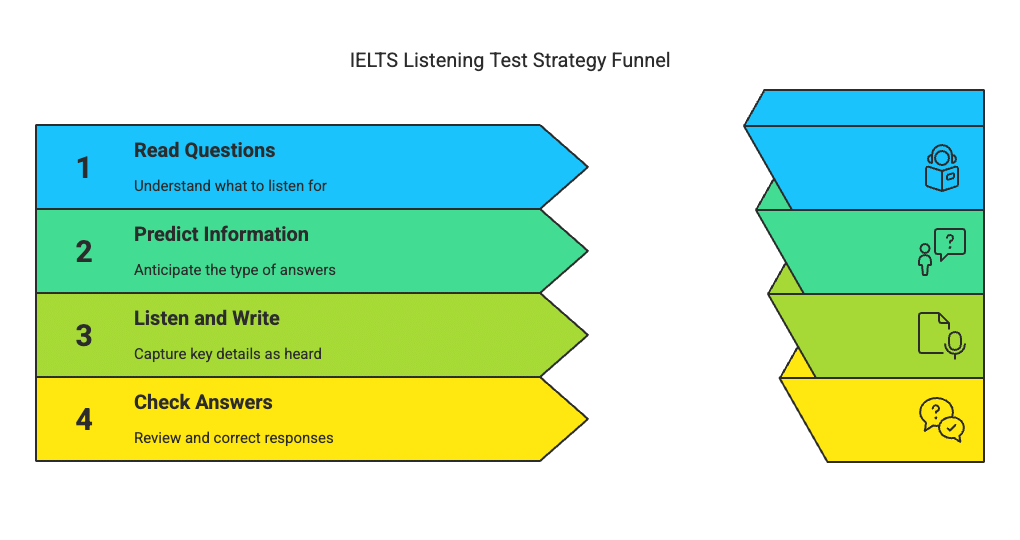Tips and Tricks: Listening for Names, Time and Numbers | Listening for IELTS PDF Download
| Table of contents |

|
| 1. Listening for Names |

|
| 2. Listening for Time |

|
| 3. Listening for Numbers |

|
| Final Tricks and Strategies |

|
The IELTS Listening Test can seem easy at first, but it requires sharp focus and attention to details, especially when it comes to names, times, and numbers. These elements often appear in form-filling, notes, and short-answer questions, and they’re frequently used to test your accuracy and listening skills. Here's how you can tackle them effectively.
1. Listening for Names
In the IELTS Listening Test, names often appear in form-filling tasks, registration conversations, or informal dialogues. These names can be foreign, unusual, or very similar to other names, making them easy to mishear or misspell.
Getting names wrong can cost you valuable marks — even a minor spelling mistake is marked incorrect. So, this is a skill worth practising in detail.
Why are Names Challenging?
Names are often unfamiliar or rarely heard.
They may include uncommon spellings, hyphens, or silent letters.
Speakers might pronounce names quickly or unclearly.
IELTS often tests your attention to detail by using names that are similar to common ones but slightly altered.

Key Tips to Get Names Right
1. Spelling Out
When names are unfamiliar, the speaker may spell them out. You need to listen carefully to each letter, especially ones that sound alike.
Pay special attention to commonly confused sounds:
V vs. W (e.g., Victor vs. Walter)
M vs. N (e.g., Emma vs. Enna)
A vs. E (e.g., Alan vs. Ellen)
B, D, P, T – all sound similar when spoken quickly.
Write the letters down as you hear them and double-check their order.
Example:
“Her name is spelled V-E-R-A, that’s V for Victor, E for Echo, R for Robert, A for Alpha.”
2. Capitalisation
Always capitalise names, even if it's a first name, last name, or middle name.
Incorrect: mcgregor
Correct: McGregor
If the name starts with “Mc”, “O”, or “de”, pay attention to proper formatting.
Example:
"His surname is O’Donnell — don’t forget the apostrophe and capital ‘D’.”
3. Hyphenated Names
You may hear names like Anna-Louise or Jean-Paul.
The speaker will usually say “hyphen” or “dash” in between.
Write the hyphen clearly between the names.
Example:
“That’s Sarah-Jane, with a hyphen between the two names.”
4. Watch for Silent Letters and Unusual Pronunciations
Some names may sound different from how they are spelt.
For instance:
“Knight” (silent K)
“Sean” (pronounced ‘Shawn’)
“Cholmondeley” (pronounced ‘Chumley’ — rare but possible in advanced tests)
Don’t try to guess; rely on spelling clues in the audio.
5. Practice Common Name Spellings
Get used to common names from British, Australian, and international sources, as IELTS uses a wide cultural variety.
Listen to dialogues in movies, podcasts, and IELTS practice recordings.
Try spelling names out loud as you hear them.
Practice Tip: Listen and Write
Play a recording of someone spelling a name and write it down as they say it, then compare your version to the actual spelling. Focus on accuracy and speed.
Sample IELTS-Style Dialogue
Audio Excerpt:
“Yes, that’s right. The name is Geoffrey, G-E-O-F-F-R-E-Y. And the surname is Delacroix — that’s D-E-L-A-C-R-O-I-X.”
First Name: Geoffrey
Last Name: Delacroix
2. Listening for Time
Understanding how time is expressed in English is a key skill in the IELTS Listening test. Time-related information appears frequently in form-filling tasks, booking conversations, schedules, or timetables. The test can use both formal and informal expressions, so you need to be comfortable with a variety of formats.
Why Time Can Be Tricky
English uses both 12-hour and 24-hour formats.
Times are often stated in casual, conversational ways.
AM/PM may not always be clearly stated – you need to pick it up from context.
Mishearing even a small detail (like “half past” Vs. “quarter past”) can result in a wrong answer.

Essential Tips for Listening for Time
1. Pay Attention to AM/PM
The difference between 6 AM and 6 PM can completely change the meaning of the sentence.
Sometimes the speaker won’t directly say “AM” or “PM” but will mention clues:
“in the morning” = AM
“in the evening/afternoon” = PM
“after lunch”, “before work”, etc., can also hint at the time of day.
Example:
“The meeting is at five — in the evening.” → 5:00 PM, not 5:00 AM.
2. Get Comfortable with Casual Time Phrases
English speakers often use natural, conversational phrases when talking about time:

Practice recognising these phrases so you can quickly convert them into standard numerical format.
Example:
“Let’s meet at ten to eight.” → 7:50

3. Recognise the 24-hour Format
Commonly used in formal settings, such as train or flight schedules, university timetables, or public service announcements.
The time after 12:00 is shown by adding hours:
13:00 = 1:00 PM
16:30 = 4:30 PM
21:15 = 9:15 PM
Make sure to convert the time correctly in your answer if needed. For example, if the answer box shows a 12-hour clock format, don’t write “14:00.”
4. Use the Context for Clues
If the speaker says:
“evening yoga class” and then mentions “six,” it's probably 6 PM.
“early morning shift” and mentions “five,” it’s likely 5 AM.
Contextual words help you understand the implied time, even if AM or PM isn’t clearly stated.
Example:
“The doctor’s appointment is at quarter past four in the afternoon.” → 4:15 PM
5. Double-Check What the Question Asks
Sometimes the question may ask you to write:
Just the time (e.g., “9:30”)
The time with AM/PM (e.g., “9:30 AM”)
In 24-hour format (e.g., “09:30”)
Always follow the instructions exactly. Marks are lost for using the wrong format, even if the time is correct.
3. Listening for Numbers
Numbers appear frequently in the IELTS Listening test — in addresses, dates, prices, phone numbers, ages, measurements, and more. They might be spoken quickly, grouped differently, or sound similar, making them easy to mishear. That's why developing a strong ear for numbers is crucial.
Key Tips for Listening to Numbers
1. Understand Number Grouping (Especially in Phone Numbers)
British and Australian speakers often group numbers or use specific expressions:
“Double three” means 33
“Oh” is used instead of “zero” in phone numbers (e.g., “Oh eight four” = 084)
Example:
“Call me on oh-seven-nine-double five-nine-two-eight.” → 07955928
Practice listening to phone numbers and addresses to get used to these patterns.
2. Pay Attention to Intonation and Pauses
Speakers often pause slightly between number groups (especially in long numbers or dates). Listen carefully for:
Natural pauses to split up parts of a phone number
Emphasis changes to highlight prices or measurements
Example:
“It’s six-zero-five, and the flat number is twenty-two B.”
→ 605 (street number), 22B (apartment)
3. Watch Out for Similar-Sounding Numbers
English speakers sometimes blur the difference between similar numbers, especially when spoken fast.

Tip: Numbers ending in “-teen” usually have more stress on the second syllable (thir-TEEN), while those ending in “-ty” are stressed on the first (THIR-ty).
4. Check Units and Symbols
Always include the correct unit, especially when:
Prices are given: use £, $, or €
Measurements: like “kg”, “litres”, “cm”, “metres”
Time and dates: “a.m.”, “p.m.”, or full date format if required
Example:
“The parcel weighs about ten point five kilograms.” → 10.5 kg
If the question asks for a number only, don’t write the unit. Always read instructions carefully!
5. Familiarise Yourself with Prices and Currencies
You may hear:
“Forty-five pounds fifty” → £45.50
“Two thousand three hundred dollars” → $2,300
“Ninety-nine cents” → $0.99 or 99¢
Example:
“The ticket costs forty-five pounds fifty.”
→ £45.50
Also, some speakers may say “point” or “decimal” clearly, while others may say it quickly, so stay alert for “point” in prices and measurements.
Final Tricks and Strategies
Use the time before each section to read the questions and underline keywords — especially blanks needing a name, time, or number.
Predict the type of information you expect to hear: e.g., a name, a date, a time.
Write as you listen – don’t wait to hear everything. Focus on getting the exact word/number.
Check spellings and grammar during the 10 minutes given at the end to transfer your answers.

|
104 videos|39 docs
|
FAQs on Tips and Tricks: Listening for Names, Time and Numbers - Listening for IELTS
| 1. What are the best strategies for listening for names in the IELTS exam? |  |
| 2. How can I improve my ability to listen for times in the IELTS listening section? |  |
| 3. What techniques can I use to listen for numbers effectively during the IELTS test? |  |
| 4. Are there specific types of questions in the IELTS listening section that focus on names, times, and numbers? |  |
| 5. How can I practice listening skills for names, times, and numbers before the IELTS exam? |  |















